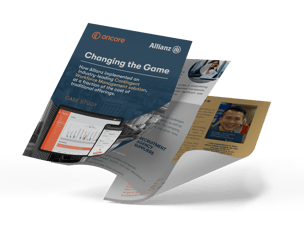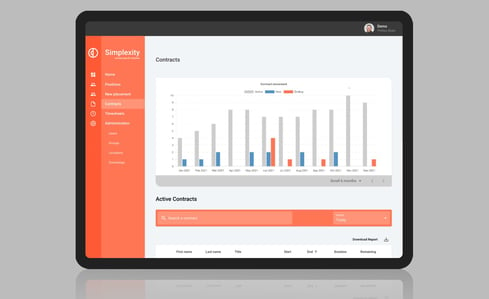b. System/Technology:
Many larger organisations use a dedicated system for managing their contingent workforce suppliers because of the intricacies of the on-demand model and the varying contracts and fees associated with CW suppliers like recruiters. Vendor Management Systems (VMS) are often used for this as they are built for managing suppliers. There is an emerging trend however, where new centralised platforms are being developed purely to cater to this growing market.
Read the real-life case study here on how Allianz implemented Oncore's industry-leading Contingent Workforce Management solution with massive success.
c. Management of CW program:
CW programs can be managed internally by a dedicated person/department and/or outsourced to an MSP (managed service providers). This includes running the job requisition and recruitment processes, etc. Whoever manages the program has to be able to manage the technology used for the program as well as managing the suppliers (recruitment agencies).
For a complete breakdown of the current and emerging CW models in the market please email our team to be the first to receive our brand new whitepaper on the subject.
Why every company needs a CW Program: The Changing Workforce
1. Rise of Remote Work
The intensifying shift towards remote work continues to reshape the way businesses operate. Contingent workforce programs, designed to accommodate remote work seamlessly, are becoming truly indispensable. As companies continue to embrace distributed teams, the ability to tap into a contingent workforce provides unparalleled flexibility, enabling organisations to scale their workforce based on project requirements without geographical constraints.
Dr Connie Zheng, Co-Director of the University of South Australia’s Centre for Workplace Excellence, sees working from home to continue in 2025 despite talk of a rising demand for employees to work on-site due to the shortage in high-end skills and talent.
The skill and talent shortage in Australia has not eased yet, despite the recent change of migration law that seeks to attract more high-end skills, Zheng said. This could only encourage those workers who are more likely to demand that flexible work arrangements, like working from home or remote working, be offered by their employers.
Instead of compelling workers to return to traditional office settings, it is likely to encourage those with sought-after skills to assert their preferences for flexible work arrangements. In a competitive job market where skilled professionals are in demand, companies need to be more accommodating in offering flexible work options to attract and retain top talent.
2. Gig Economy Trends
The gig economy, characterised by short-term and flexible employment arrangements, has gained significant traction. Companies are increasingly recognising the value of gig workers and leveraging them through contingent workforce programs. This trend not only allows organisations to access a diverse pool of specialised skills but also fosters innovation and adaptability in the face of ever-changing market dynamics.
Advantages of Implementing a Contingent Workforce Program
1. Flexibility and Scalability
One of the primary advantages of a contingent workforce program is its ability to provide flexibility and scalability. Companies can swiftly adapt to changing workloads and project demands by tapping into the contingent talent pool. Whether it's a short-term project or a sudden surge in workload, a contingent workforce allows organisations to scale their teams up or down without the complexities of traditional hiring processes.
2. Access to Specialised Skills
Contingent workers often bring unique and specialised skills to the table. Through a contingent workforce program, companies can access a diverse pool of talent with expertise in specific areas. This not only enhances the overall skill set within the organisation but also allows for the quick infusion of specialised knowledge required for particular projects or tasks.
3. Cost Savings
Implementing a contingent workforce program can lead to significant cost savings for organisations. Traditional hiring involves expenses such as recruitment, onboarding, benefits, and long-term commitments. In contrast, a contingent workforce allows companies to allocate resources more efficiently, reducing fixed costs associated with permanent hires. This flexibility in resource allocation is particularly advantageous in industries with fluctuating demands.
Overcoming Challenges
1. Managing Remote Teams
While the rise of remote work offers unprecedented flexibility, managing remote teams comes with its set of challenges. Contingent workforce programs need to address issues related to communication, collaboration, and team cohesion. Leveraging technology solutions for virtual collaboration, project management, and regular communication can help overcome these challenges and ensure a cohesive remote work environment. To read more on mastering remote workforce management, read Oncore's 9 step guide here: https://www.oncoreservices.com/news-resources/mastering-remote-workforce-management-a-9-step-guide
2. Legal and Compliance Considerations
Navigating the legal and compliance landscape is crucial when managing a contingent workforce. Companies must ensure that their contingent workforce program complies with labour laws, tax regulations, and other relevant legal requirements. Engaging legal experts and implementing robust compliance measures are essential to mitigate risks associated with contingent workforce management.
The time to act is now
A contingent workforce program is not just a trend; it's a strategic imperative for companies looking to thrive in 2024. The ability to adapt swiftly to changing market conditions, access specialised skills, and achieve cost efficiencies, positions organisations for sustained success. As we embrace the future of work, integrating a contingent workforce program is no longer an option but a necessity for companies aspiring to remain competitive and agile in the years to come. For more insights into how and why to adapt your strategy for a distributed workforce read our previous blog below: www.oncoreservices.com/news-resources/how-to-adapt-your-recruiting-strategy-for-a-distributed-workforce
Explore how Oncore can elevate your contingent workforce strategy
Whether you're exploring the possibilities of a contingent workforce for the first time or looking to enhance your existing approach, get in touch to find out how Oncore can help elevate your contingent workforce strategy in 2024.












_11zon%20(1).jpg?width=302&height=124&name=linkedin-sales-solutions-vqWWOnA6--M-unsplash%20(2)_11zon%20(1).jpg)








